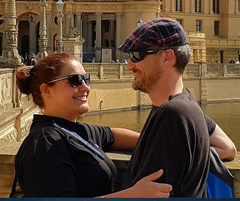
Andrew Hallam
15.05.23
Retirees Might Need More Than $4.5 Million To Keep Up
With This Teaching Couple
_
Plenty of professionals from North America and Europe gravitate to the Middle East and Southeast Asia. Many are drawn to higher incomes and lower taxes. But they have to save…a lot. If they don’t, their previous homebound colleagues could enjoy far plusher retirements. Others who moved to higher taxed countries could end up richer too. Sound crazy? It isn’t.
In 2016, Americans Gus Peterson and his wife, Janice, moved from the US to Germany to teach at an international school. Forty-eight year old Gus teaches Economics in Hamburg; 43-year old Janice teaches German.
Salaries in Germany are often lower than they are in the Middle East and Southeast Asia. Taxes are also high. But Gus and Janice know something that plenty of expats don’t.

Pensions can pack a punch. That’s why you might need more than $4.5 million to keep pace with Gus and Janice.
“Defined benefit” pensions or government pensions are not investment accounts. They represent monthly income that retirees receive based on a calculation of their age, income, and the number of years they contributed to it. It’s what most teachers, health care professionals or government workers contribute to in the UK, Canada, Australia, New Zealand and most of Europe.
Gus and Janice plan to retire in about 20 years. They are slated to receive a combined, estimated $3000 a month ($36,000 a year) from US Social Security and a further $500 a month ($6000 a year) from their Oregon State teaching pensions.
The couple’s combined income from their German government pensions will total about 3,576€ per month (42,912€ a year). Converted into USD, that’s about $3,931 per month, or $47,179 per year. “The German pensions would be a lot higher if we started working here earlier,” says Gus. “I was already forty years old when I began working in Germany.”
Still, the couple will receive about $89,179 per year in pensionable income. That won’t have the same buying power, 20 years from now, because of inflation. But it’s still a decent sum. And after Gus and Janice begin receiving this income, the US and German governments will increase these payments to keep pace with inflation.
People without such pensions will need more than $2.2 million in a portfolio of index funds just to equal what Gus and Janice will receive from their pensions.
This is based on the 4 percent rule of thumb, which I explain in detail here.
Fortunately, Gus and Janice are also layering two other levels to their retirement cake.

Get International Investing insights
in your inbox once per month
They currently have about $390,000 USD in a diversified portfolio of index funds. They are adding about $10,000 a year. If they maintain their annual contributions over the next 20 years, their portfolio will be worth the following amounts, based on these respective rates of return.
$390,000 + $10,000 per year for 20 years
@5% = $1,381,978
@6% = $1,640,710
@7% = $1,947,828
@8% = $2,312,002
If their portfolio averages 6 percent per year, they’ll have about $1,640,710 in 2043.
Based on the 4 percent rule, this could provide Gus and Janice with another $65,628 a year upon retirement.
And they could increase those withdrawals to align with the rising cost of living. An investment property comprises the next layer of their cake. “We own a house in Oregon,” says Gus. “The tenants are paying $1,600 a month, and the home will be mortgage free in 2036.” If, after expenses, Gus and Janice earn $1,200 a month from the property, this would provide them with a further $14,400 a year (in 2023 dollars). And because they can increase the rent with the rising cost of living, it could provide $28,652 a year in 2043 (assuming an inflation rate of about 3.5 percent).

When we add the investment portfolio’s future income with the pensions and the property income, it could generate income of about $183,459 starting in 2043.
Gus and Janice’s 2043 Estimated Retirement Cash Flow*
| Income Source | Annual Cash Flow |
|---|---|
Social Securitys | $36,000 |
German Government Pensions | $47,179 |
Oregon State Teacher’s Pensions | $6000 |
Real Estate Income* | $28,652 |
Portfolio Income** | $65,628 |
Total Annual Income | $183,459 |
|
|
2043 Portfolio Value Equivalent For Equal Cash Flow Without Pensions or Rental Property | $4,586,475 |
* Based on 3.5% inflation
** Based on 6% annual return
So, if you won’t be receiving pensionable income or income from a rental property, you’ll need about $4.58 million in a portfolio of index funds (in 2043) to keep pace with Gus and Janice. If inflation does average 3.5 percent annually, $183,459 would have the same buying power as $92,200 in 2023.
I did, however, leave out a few subtle details. Janice is four years younger than Gus, so she’ll qualify for her full pensionable benefits a few years after Gus. But on the flipside, Gus and Janice’s salaries will likely increase over the next 20 years. That means, instead of investing $10,000 a year, they could be investing $12,000 a year by 2028, $14,000 by 2035 and $16,000 by 2040.
What’s more, I estimated a compound annual return of 6 percent for their diversified portfolio of index funds. Based on history, the long-term average over the next 20 years will likely be higher than that.
As for where they’ll retire, “Janice wants to stay in Hamburg,” says Gus. “We’ll be able to use the German medical system. I prefer a warmer place in the winter. But at least Germany has good beer.”
Andrew Hallam is a Digital Nomad. He’s the bestselling author Balance: How to Invest and Spend for Happiness, Health and Wealth. He also wrote Millionaire Teacher and Millionaire Expat: How To Build Wealth Living Overseas
Swissquote Bank Europe S.A. accepts no responsibility for the content of this report and makes no warranty as to its accuracy of completeness. This report is not intended to be financial advice, or a recommendation for any investment or investment strategy. The information is prepared for general information only, and as such, the specific needs, investment objectives or financial situation of any particular user have not been taken into consideration. Opinions expressed are those of the author, not Swissquote Bank Europe and Swissquote Bank Europe accepts no liability for any loss caused by the use of this information. This report contains information produced by a third party that has been remunerated by Swissquote Bank Europe.
Please note the value of investments can go down as well as up, and you may not get back all the money that you invest. Past performance is no guarantee of future results.
